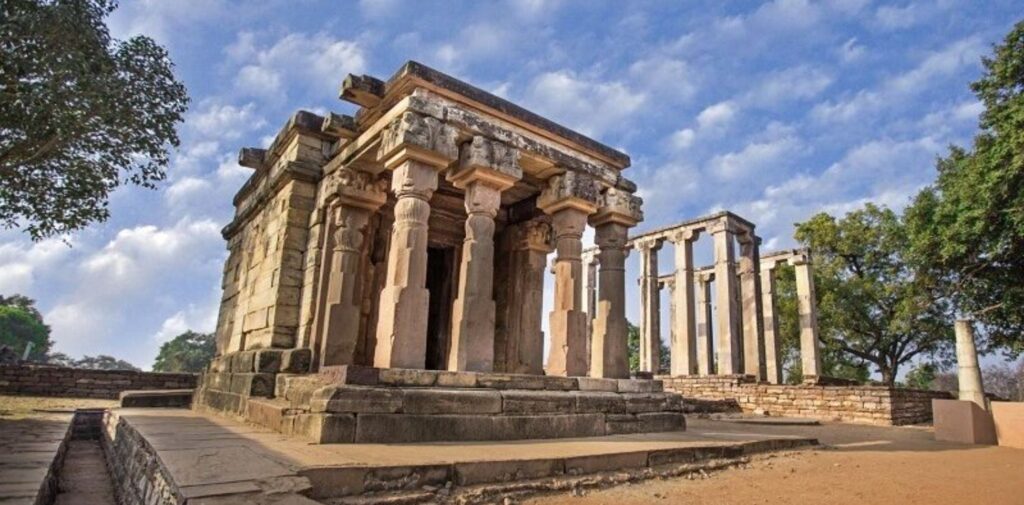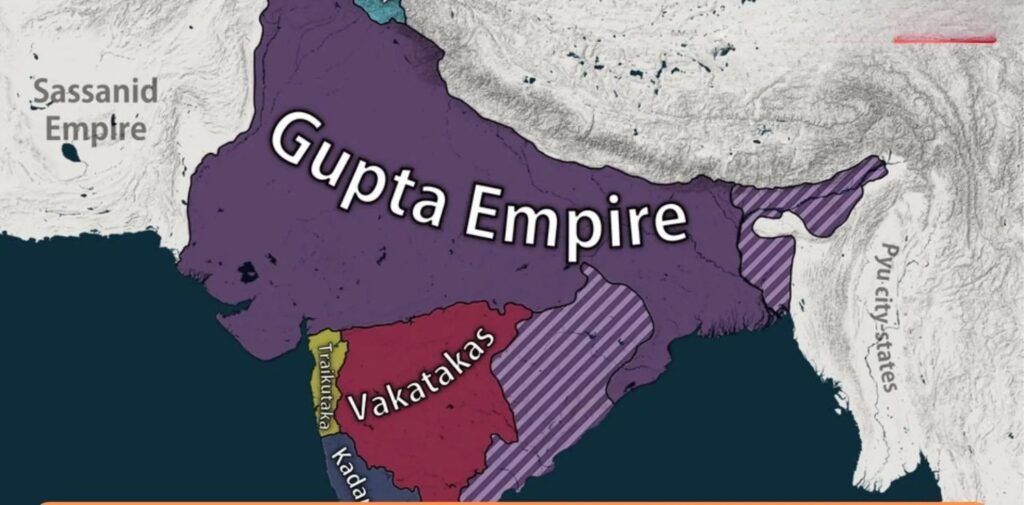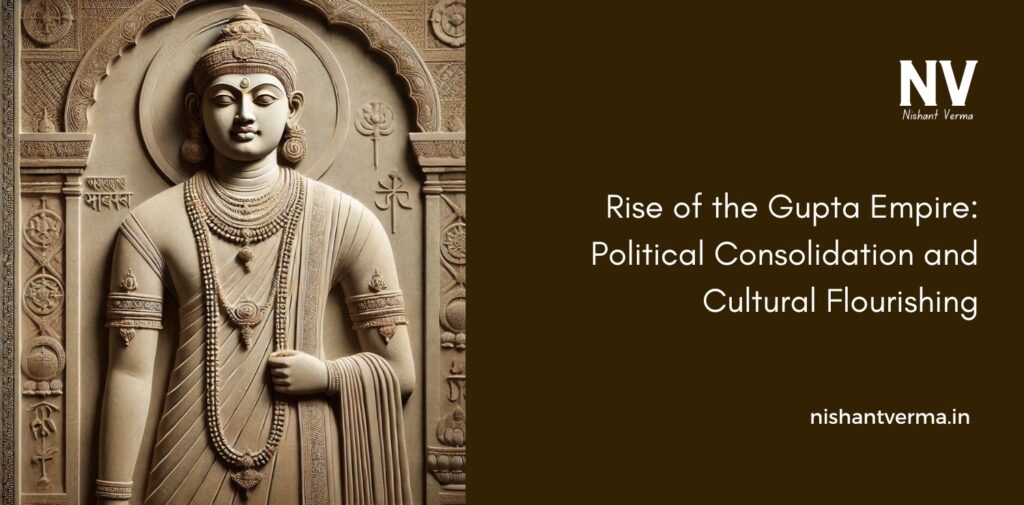The Gupta Empire is one of the most important empires in ancient Indian history. It is often called the Golden Age of India because it was a time of great achievements in art, science, literature, and culture. The Gupta Empire brought peace and prosperity to much of India and helped shape the future of the subcontinent. In this article, we will learn about how the Gupta Empire rose to power, what made it so successful, and how it helped India flourish in many ways.
The Beginning of the Gupta Empire
The Gupta Empire began around 320 CE, when Chandragupta I became the ruler. He was the first Gupta king to establish a strong kingdom. Before Chandragupta I, India was divided into many small kingdoms and regions, each ruled by different kings. However, Chandragupta I was able to unite many of these regions and create a strong empire.
Chandragupta I married a princess from the Licchavi clan, which helped him gain power and influence in the region. With this marriage, he not only became a powerful king but also started a dynasty that would rule India for several centuries. The Gupta family, after Chandragupta, would go on to become one of the most famous and successful dynasties in Indian history.

Chandragupta I and His Successors
After Chandragupta I, the most famous ruler of the Gupta Empire was Samudragupta, his son. Samudragupta was a brilliant military leader who expanded the empire to many parts of India, from the northern plains to the Deccan region. He defeated many powerful kingdoms and brought them under his control. Samudragupta is also remembered for his kindness to conquered kingdoms. Instead of destroying them, he often allowed local rulers to keep their positions as long as they agreed to accept Gupta rule.
The empire reached its peak under Chandragupta II, also known as Vikramaditya. Chandragupta II continued his father’s and grandfather’s work, expanding the empire even further. Under his rule, the Gupta Empire became one of the largest and most prosperous empires in Indian history.
Political Consolidation
One of the main reasons for the success of the Gupta Empire was its strong political consolidation. Political consolidation means the process of bringing together smaller kingdoms or regions into one united empire.
The Gupta rulers worked hard to bring peace and order to the regions they controlled. They set up a well-organized government with strong laws to maintain law and order. The Gupta rulers also created a system of officials to manage the day-to-day affairs of the empire, such as collecting taxes, maintaining roads, and organizing the military.
Even though the Gupta Empire was large, the kings did not rule by force alone. They often relied on a system of local rulers who helped govern smaller regions. These local rulers were given some independence as long as they supported the Gupta emperor. This system helped the empire run smoothly and kept the people loyal to the Gupta kings.

A Time of Peace and Prosperity
Under the Gupta Empire, India enjoyed a long period of peace and prosperity. The empire’s strong political organization and wise leadership allowed the people to live without the fear of wars and invasions. This peace helped create a stable environment in which trade, agriculture, and business could flourish.
The Gupta Empire was also famous for its golden age of art, literature, and science. Because the kings supported scholars and artists, this period saw the growth of Indian culture in many different areas. Let’s explore some of the important cultural developments that happened during the Gupta Empire.
Achievements in Art and Architecture
One of the most important aspects of the Gupta Empire was its achievements in art and architecture. The Gupta period saw the creation of beautiful sculptures, paintings, and temples. The most famous examples are the Ajanta and Ellora caves in Maharashtra, where ancient Indian artists painted colorful murals and created stunning sculptures of gods and goddesses. These artworks are still admired today for their beauty and detail.
The Gupta Empire is also known for its temple architecture. The Gupta rulers built many temples dedicated to Hindu gods and goddesses, and these temples became centers of religious and cultural life. The temples were often large and beautifully decorated with carvings and sculptures. This style of architecture became known as Gupta architecture and influenced many later temples in India.
Advancements in Science and Mathematics
The Gupta Empire is also remembered for its great achievements in science and mathematics. One of the most important contributions during this time was the development of zero as a number. The famous mathematician Aryabhata made several important discoveries in mathematics and astronomy. He is believed to have been the first to explain that the Earth is round and rotates on its axis.
Aryabhata also made important contributions to trigonometry and algebra. The decimal system, which is the number system we use today, was also developed during the Gupta period. This was a huge breakthrough in mathematics and helped scientists and traders perform calculations more easily.
Other scholars during the Gupta period, like Varahamihira and Brahmagupta, made important advances in astronomy, medicine, and physics. These discoveries were so advanced that they were not fully understood by people in other parts of the world for many years.
Literature and Poetry
The Gupta Empire was a time of great growth in literature and poetry. One of the most famous writers from the Gupta period was Kalidasa, who is considered one of the greatest poets in Indian history. Kalidasa wrote plays and poems in Sanskrit, the ancient language of India. His works, such as Shakuntala and Meghaduta, are still performed and read today.
The Gupta period also saw the writing of important texts in other fields, such as medicine, law, and religion. Scholars wrote books on subjects like the science of medicine (called Ayurveda) and the teachings of Hinduism. The Gupta kings were great patrons of literature, and they encouraged writers and poets to create works that are still studied today.

The End of the Gupta Empire
The Gupta Empire did not last forever. After the death of Chandragupta II, the empire slowly started to decline. This decline was caused by several factors, including weak rulers, invasions from the Huns (a group of nomadic warriors from Central Asia), and economic problems. The Huns invaded northern India in the 5th and 6th centuries, and their attacks weakened the Gupta Empire. Over time, the empire broke apart into smaller kingdoms, and by the 6th century, the Gupta Empire had collapsed.
Consequences of the Gupta Empire’s Decline
The decline of the Gupta Empire led to a period of political instability and regional fragmentation in India. However, the achievements of the Gupta Empire were not forgotten. The cultural, scientific, and artistic advancements made during the Gupta period continued to influence India for centuries.
Even though the empire fell, the ideas of the Gupta Empire, especially in fields like mathematics, astronomy, and literature, had a lasting impact on India and the world. The Gupta period is often remembered as a time of peace, prosperity, and cultural flourishing, and it left behind a rich legacy that shaped the future of India.
Conclusion
The rise of the Gupta Empire marked a golden age for India, with advancements in art, science, literature, and architecture. The Gupta rulers brought political stability to the region, uniting many small kingdoms and creating a strong empire. During their rule, India saw incredible achievements in mathematics, astronomy, and literature that continue to influence the world today.
Though the empire eventually declined, the Gupta period is remembered as one of the most important and prosperous times in Indian history. The legacy of the Gupta Empire continues to shine brightly in the fields of culture, science, and the arts.




